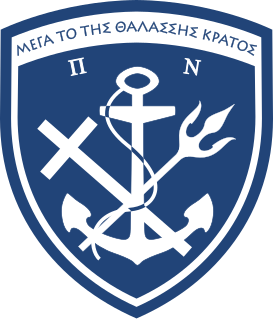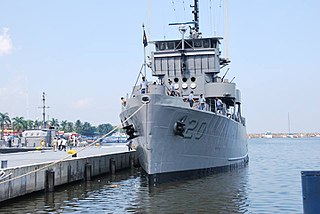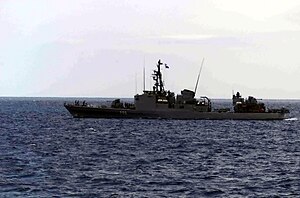
In naval terminology, a destroyer is a fast, maneuverable, long-endurance warship intended to escort larger vessels in a fleet, convoy or battle group and defend them against powerful short range attackers. They were originally developed in 1885 by Fernando Villaamil for the Spanish Navy as a defense against torpedo boats, and by the time of the Russo-Japanese War in 1904, these "torpedo boat destroyers" (TBDs) were "large, swift, and powerfully armed torpedo boats designed to destroy other torpedo boats". Although the term "destroyer" had been used interchangeably with "TBD" and "torpedo boat destroyer" by navies since 1892, the term "torpedo boat destroyer" had been generally shortened to simply "destroyer" by nearly all navies by the First World War.
Twelve ships of the Royal Navy have borne the name HMS Thetis, named after the sea-nymph in Greek mythology:

The Hellenic Navy is the naval force of Greece, part of the Hellenic Armed Forces. The modern Greek navy historically hails from the naval forces of various Aegean Islands, which fought in the Greek War of Independence. During the periods of monarchy it was known as the Royal Hellenic Navy.

HMS Yarmouth was the first modified Type 12 frigate of the Rothesay class to enter service with the Royal Navy.

BAPFerré(DM-74) was a Daring-class destroyer in service with the Peruvian Navy from 1973 to 2007. She was built by Yarrow Shipbuilders and completed for the Royal Navy in 1953 as HMS Decoy (D106).

The Osprey 55-class gunboat is a Danish-designed class of naval ship currently in service in the Hellenic Navy and Royal Moroccan Navy. Two ships were ordered by Greece in March 1988 and built by Hellenic Shipyards. The first one was laid down on 8 May 1989 and launched on 19 December 1989. The second ship was laid down on 9 November 1989 and launched on 16 May 1990. Armament is of modular design and therefore can be changed. 76-millimetre (3 in) guns replaced the Bofors 40 mm (1.6 in) guns in 1995, after being taken from decommissioned Gearing-class destroyers. Options on more of the class were shelved in favour of the slightly larger HSY-55 class.

The Greek destroyer (τορπιλλοβόλον) Doxa, served in the Royal Hellenic Navy from 1907–1917. She was one of four Niki-class destroyers ordered from Germany in 1905 and was built in the Vulcan shipyard at Stettin.

BRP Magat Salamat (PS-20) is one of several Miguel Malvar class of patrol corvettes in service with the Philippine Navy. She was originally built as USS Gayety (AM-239), an Admirable-class minesweeper with a similar hull to the PCE-842-class patrol craft produced during World War II. In 1962 she was transferred to South Vietnam for service in the Republic of Vietnam Navy as RVNS Chi Lang II (HQ-08). She was acquired by the Philippine Navy in April 1976 and later on commissioned as Magat Salamat. Along with other ex-World War II veteran ships of the Philippine Navy, she is considered one of the oldest active fighting ships in the world today.

USS PGM-18 was a PGM-9-class motor gunboat built for the United States Navy during World War II. She was built and originally commissioned as USS PC-1255, a PC-461-class submarine chaser, and was decommissioned and converted in late 1944. USS PGM-18 struck a mine off the coast of Okinawa in April 1945; 13 men lost their lives when PGM-18 sank.

HMS Caicos was a Colony-class frigate of the United Kingdom that served during World War II. She was originally ordered by the United States Navy as the Tacoma-class patrol frigate USS Hannam and was transferred to the Royal Navy prior to completion. It was named after the Caicos Islands.

The American Flower-class corvettes were those ships of the Royal Navy's Flower class built for, or operated by, the United States Navy during World War II. These were ten ships of the original Flower class, known as the Temptress class in US service, and fifteen Modified Flowers, as the Action class. They were classified as Patrol Gunboats (PG)

SMS Thetis was the fourth member of the ten-ship Gazelle class of light cruisers that were built for the German Kaiserliche Marine in the late 1890s and early 1900s. The Gazelle class was the culmination of earlier unprotected cruiser and aviso designs, combining the best aspects of both types in what became the progenitor of all future light cruisers of the Imperial fleet. Built to be able to serve with the main German fleet and as a colonial cruiser, she was armed with a battery of ten 10.5 cm (4.1 in) guns and a top speed of 21.5 knots.

Peyk-i Şevket was a torpedo cruiser of the Ottoman Navy, built in Germany in 1906–07, the lead ship of her class, which included one other vessel. She was built by the Germaniawerft shipyard in Germany in 1906–07, and was delivered to the Ottoman Navy in November 1907. The ship's primary armament consisted of three 450 mm (18 in) torpedo tubes and a pair of 105 mm (4.1 in) guns, and she was capable of a top speed of 21 knots. A major reconstruction in the late 1930s revised her armament and rebuilt her bow and superstructure.
At least three ships of the Hellenic Navy have borne the name Niki :
At least three ships of the Hellenic Navy have borne the name Doxa :

Commandant Rivière was a Commandant Rivière-class frigate of French Navy.














